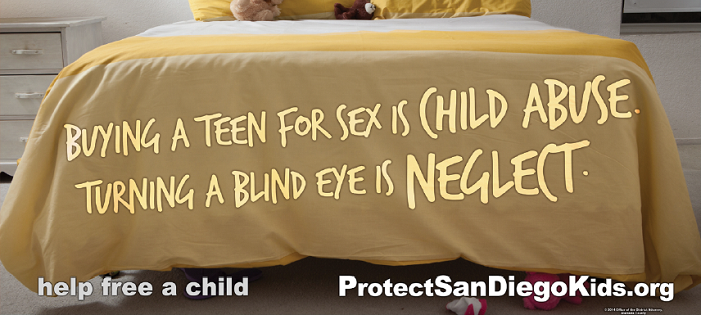
Human Trafficking FAQs

What is Human Trafficking?
Human trafficking is a form of modern-day slavery where perpetrators profit from the sexual exploitation and/or forced labor of men, women and children. It is a violation of basic human rights, and it is also a crime as defined by U.S. federal law and California state law.
Sex trafficking is the exploitation of a person by means including coercion or deceit to engage in commercial sexual activity, prostitution, exotic dancing, or pornography. (When the victim is a minor under the age of 18 years old, sex trafficking does not require force or coercion. Minors cannot legally consent to sexual activity)
Labor trafficking is the exploitation of a person by means including coercion or deceit for labor services. Labor trafficking victims are often forced into domestic servitude, construction, restaurant, agricultural, massage parlors, or sweatshop factory work with little or no pay.
Human Trafficking Facts and Figures
- Human trafficking is not a choice. A person cannot consent to become enslaved.
- Human trafficking is different than smuggling. Smuggling is based on transportation; trafficking is based on exploitation (although the two can occur together).
- Human trafficking does not require that a victim be moved over state or international borders. Human Trafficking is also a domestic issue inside CA state and San Diego County.
- 27 million people are trafficked each year worldwide, with approximately 18,000 victims in the U.S. (U.S. Department of State)
- Human trafficking is one of the most profitable criminal enterprises with estimates of profit worldwide of $32 billion, and 9.5 billion annually in the U.S.
- California, a populous border state with a significant immigrant population is one of the nation’s top four destination states for trafficking of human beings.
- San Diego was identified by the FBI as of the top 13 high intensity child prostitution areas.
- Human Trafficking that is based in sexual exploitation and its related forms of pimping and pandering form the majority of criminal prosecutions.

Who are the Victims of Human Trafficking?
- Victims of human trafficking include children, women and men.
- Victims of human trafficking can be domestic or foreign to include U.S. citizens and legal residents, or foreign nationals including those legally documented or undocumented.
- Victims regularly include runaway youths solicited and recruited for prostitution and other forms of sexual exploitation.
- Victims often have backgrounds of child abuse/domestic violence, but do span every socioeconomic and family background.

Who are the Perpetrators of Human Trafficking?
- Attempt to induce or persuade a child or minor under the age of 18 to engage in prostitution, pornography or other forms of sexual exploitation.
- Deprive or violate the personal liberty of anyone 18 or above through means including coercion, duress or deceit to engage the victim in prostitution, pornography or other forms of sexual exploitation.
- Deprive or violate the liberty of anyone under or over the age of 18 through means including coercion, duress or deceit to obtain forced labor or services.
- Perpetrators include family members, boyfriends, peer recruiters and organized criminals and gangs.

What are the warning signs of human trafficking based on sexual exploitation of a Minor?
Parents, teachers, employers, counselors, nurses, doctors, other professionals and friends of trafficking victims are often unaware of the abuse that is happening right in front of their eyes.
- Running away from home
- Truancy, chronic absenteeism
- Sudden drop in grades
- Change of friends or alienation from regular friends
- Rumors among students regarding sex activities
- Sudden change in behavior, attitude or attire
- Anger, aggression, being suicidal or fearful
- Claims of a new and mysterious/secretive “boyfriend”
- Use of drugs (i.e. marijuana and ecstasy)
- Weight loss
- Bruises or other physical trauma
- New cell phone or multiple cell phones
- Use of terminology related to prostitution
- Tattoos that are related to pimping/prostitution activity
- Secrecy with social media and phone
A more extensive list with indicators of human trafficking based in forced labor or servitude and sex exploitation can be found on the "National Resource Center (NHTRC)" tab.

What has the San Diego DA's Office done to fight human trafficking?
- The Sex Crimes and Human Trafficking Unit consists of specialized prosecutors, investigators, paralegals, victim advocates and staff to combat human trafficking on all fronts: Detection, Prevention, Education and Prosecution. (Sex Crimes and Human Trafficking Unit: 619-615-6426)
- Collaborating with its law enforcement partners to more effectively prosecute perpetrators. (Prosecutions tripled as compared to 2009)
- Collaborating with community service providers in order to better serve victims of crime.
- Providing specialized training to DA victim advocates to further the compassionate treatment of victims.
- Providing training to law enforcement, prosecutors and community partners.
- Using computer technology to accurately track the increased involvement of gangs with human trafficking.
- Supported legislation that holds perpetrators accountable while treating victims with dignity.
- Promoted Awareness and Prevention through implementation of the Posting Law (SB1193) and the adapting the ProtectSanDiegoKids.org Billboard campaign that originated by the Alameda DA’s office.
- Participated in Human Trafficking Law Enforcement and Multi-disciplinary task forces.
- Created and utilized the “Girls Only” toolkit to prevent girls from falling prey to traffickers through the Girls and Boys Club organization.
